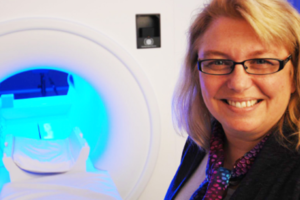Deanna M. Barch, PhD, an expert in cognitive and language deficits in psychological disorders, and Randall J. Bateman, MD, a leading Alzheimer’s disease researcher, have been elected to the National Academy of Medicine, a part of the National Academy of Sciences.
Membership in the organization is extended to those who have demonstrated outstanding professional achievement and commitment to service and is considered one of the highest honors in the fields of health and medicine in the United States.
Barch is professor and chair of the Department of Psychological & Brain Sciences in Arts & Sciences and the Gregory B. Couch Professor of Psychiatry and professor of radiology at the School of Medicine.

Barch was recognized for her work helping to identify neural and psychological mechanisms that give rise to the symptoms of psychosis and other forms of mental illness that contribute significantly to disability.
“I am very honored to be elected, and want to thank all of those who have supported my work, including family, friends, colleagues and students,” Barch said.
Barch’s commitment to research can be seen in her prolific catalogue of peer reviewed research, which has earned her an h index of 105. Her commitment to service is apparent in her willingness to work with the media to responsibly explain what findings mean…
…Recently the National Institute on Drug Abuse awarded Barch and colleagues participating in the Adolescent Brain Cognitive Development (ABCD) study an additional $13.7 million to continue their research into adolescent brain development.
The team is using advanced brain imaging techniques, structured interviews and behavioral testing to tease out how life experiences, along with a child’s changing biology, affect brain development.
The National Academy of Medicine selected Bateman for his work in discovering the causes of Alzheimer’s disease, developing the first highly specific blood test for Alzheimer’s and initiating the first Alzheimer’s prevention trial.

Bateman pioneered a technology that lets scientists monitor the brain’s production and clearance of important proteins. This technique, known as stable isotope-labeling kinetics (SILK), was developed to measure the production and clearance of proteins that can cause Alzheimer’s disease in people. Bateman’s lab used SILK to demonstrate that clearance of amyloid beta is impaired in people with Alzheimer’s disease, while people with rare mutations produce too much of the sticky amyloid-beta protein. Then, his lab demonstrated that amyloid-plaques are associated with increased tau production, the other protein of Alzheimer’s disease production, linking amyloid and tau together to indicate how Alzheimer’s may be caused. The technology also has helped scientists assess the effectiveness of experimental Alzheimer’s treatments.
Bateman has been at the forefront of efforts to develop diagnostic tools for Alzheimer’s disease. With colleagues, he developed a blood test for amyloid and a separate test for tau, another Alzheimer’s protein. Both tests detect signs of the disease in people before symptoms arise. Once drugs are available to halt the disease process, having a simple blood test that identifies people on track to develop dementia while they are still mentally sharp would allow for early treatment that potentially could vastly reduce the burden of this very common and devastating disease.
